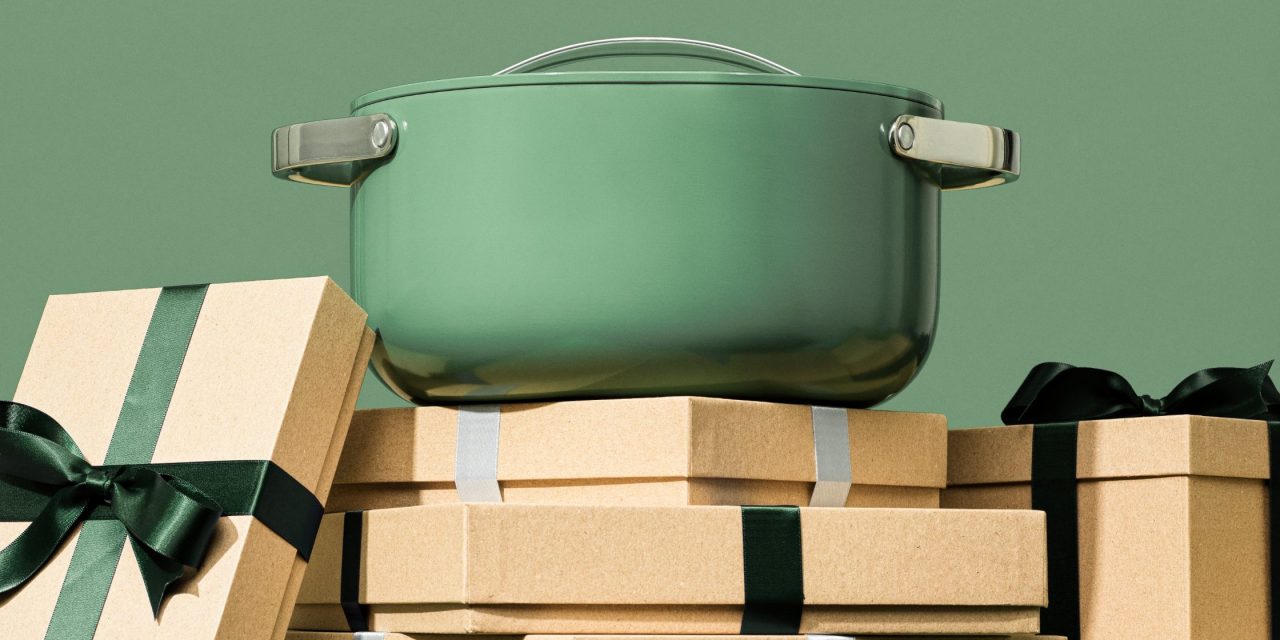Cookware brand Caraway is now selling all its products at The Container Store

Cookware brand Caraway is the latest among many direct-to-consumer brands to make its products available nationwide in The Container Store.
Caraway’s full assortment — which includes pots, pans and bakeware — will now be available for purchase in about 80 The Container Store locations. The company has six product categories and a couple hundred SKUs. The Container Store is the first retailer to carry Caraway’s entire portfolio.
The brand initially partnered with The Container Store last year when it launched its cookware set in five stores. Caraway Founder and CEO Jordan Nathan said it expanded its partnership with the retailer after its initial launch was deemed a success. Caraway is one of several brands that have inked a distribution deal with The Container Store this year.
“I think Container Store is doing a great job right now shifting a lot of their merchandising around newer brands,” Nathan said in an interview. “I think we have the unique opportunity with them to help build out the kitchen category.”
The Container Store previously told Modern Retail that it has been updating its assortment by bringing more DTC brands into the fold. Modern Picnic — which sells products like picnic bags and lunch bags — entered brick-and-mortar retail for the first time through The Container Store in May, while travel container brand Cadence started being available at The Container Store in September. In an earnings call, The Container Store said that new customers made up 24% of sales for new products in the first quarter — which signals that its refreshed assortment has attracted new shoppers.
The Container Store’s net sales have also been slipping lately, but the addition of trendier DTC brands could change things around for the retailer. Its consolidated net sales for the second quarter dropped 19.4% year-over-year to $219.7 million. Comparable store sales also declined 20% in the second quarter.
Much like The Container Store’s DTC partners, Caraway is also a relatively young brand. Nathan launched Caraway in 2019, after working for a different kitchen brand. Caraway’s ceramic-coated products are also in a total of 800 retail stores, including Target, Crate & Barrel and Nordstrom. The majority of its sales still come from its direct-to-consumer channel but Caraway estimates that it will have a 50-50 revenue split between DTC and wholesale over the next five to 10 years.
Nathan said that Caraway was drawn to The Container Store because of how it curates products in its stores and its attention to design. In The Container Store, Caraway will have two end caps with signage that talks about the brand and its mission. The company also redesigned its packaging to educate shoppers about Caraway as they shop in-store.
“We’re thrilled to be able to have the full assortment at The Container Store and have that full moment to talk about the brand and how all of our products work together,” Nathan said. “Additionally, The Container Store to date hasn’t carried cookware [or] kitchenware, and so we’re excited to be the first brand in the store offering cookware helping to expand their category.”
While The Container Store is Caraway’s first retail partner to carry its entire assortment, Nathan said that the brand has a “curated approach” with every retailer it works with. For example, Caraway’s partnership with Crate & Barrel leans heavily into exclusive colors and limited drops. At Target, Caraway is solely focused on offering cookware.
“As we look to expand, we’re really intentional with who we bring on,” Nathan said. “The consistency between who we choose across partners really comes down to [whether] we have an opportunity to educate consumers in store and we love partners who are willing to lean into the brand.”
Dan McCarthy, assistant professor at Emory University’s Business School, said that brands vastly improve their market reach when they enter retail doors. He added that having a physical retail presence helps young brands bring down their marketing costs as the cost of digital advertising grows more costly.
“It can be very good to gain exposure to audiences that otherwise would not have been familiar with the brand,” McCarthy said. “It’s pretty well accepted by this point that direct-to-consumer brands that sell primarily through digital channels have been struggling with the large and growing costs to acquire customers. And so, by being able to get in front of a much larger audience, oftentimes they’re able to keep that expense down.”
A big challenge for brands that are growing their physical distribution channels, like Caraway, is managing inventory, McCarthy said. Brands have to make sure to supply enough products in stores to avoid missing out on sales, while also avoiding overproduction. While distributing products through wholesale also cuts down marketing costs, McCarthy said brands also give up a bit of margin.
For Caraway, its partnership with The Container Store also has additional benefits as the holiday rolls around. Nathan said CarawayHome.com’s shipping cut-off date is around Dec. 15 but its presence in The Container Store can still provide products for shoppers looking for last-minute Christmas gifts.
